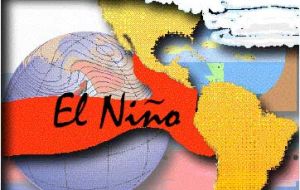MercoPress. South Atlantic News Agency
El Niño subsides: fishermen celebrate, farmers fear drought

By next May the “El Niño” phenomenon, which warms the Pacific Ocean by an average of 1.5 degrees Celsius (3.5 degrees Fahrenheit), will have completely disappeared.
While Chile's fishing industry utters a loud sigh of relief – cooler water means larger catches — the departure of El Niño could cause severe problems for the agricultural sector, which may be facing drought.
As El Niño warms the sea, more water evaporates into cloud matter, allowing farmers to count on a large quantity of rainfall for the coming season. In contrast, El Niño's "sister" phenomenon, La Niña, has the opposite effect, cooling Pacific waters and making rainfall unpredictable. When El Niño subsides, rainfall drops by an average 33%, a figure that can prove disastrous for crops. Earlier this year, scientists from Britain's University of East Anglia predicted that 2007 would be the hottest year on record. El Niño was set to enhance this trend but is living up to its capricious reputation and rapidly receding, provoking a meteorological headache and promising to make 2007 a year of drought, flooding and other "freak" weather conditions. Luis Schmidt, president of Chile's National Agricultural Society (SNA), says that his organization is taking steps to address this scenario, such as improving and expanding irrigation systems. He also took the opportunity to stress the need for a National Glacier Protection Law â€" which is currently moving through the Senate â€" and pointed out that, in the case of drought, 70% of Chile's water comes from its glaciers. Many of Chile's ice masses are currently threatened by mining projects such as the controversial Pascua Lama mine, and all face rapid diminution due to rising temperatures caused by global warming. For those making a living from Chile's seas, however, the news of El Niño's recession is a cause for celebration. In 2006 Chile's northern fisheries reported a 53% fall in anchovy catches due to a gentle year for El Niño. "We're optimistic that 2007 will be a good year," said Héctor Bacigalupo, general manager of Chile's National Fishing Society (Sonapesca). Anchovy hauls this year are expected to reach 700,000 tons. The occurrence of El Niño in 1997/1998 dealt a harsh blow for Chile's fruit and fish producers by altering rainfall patterns and provoking "the Red Tide." The Red Tide â€" referred to by scientists as Harmful Algae Bloom (HAB) â€" is the accumulation of toxic algae which concentrates in shellfish and induces Diarrhertic Shellfish Poisoning (DSB) and Paralytic Shellfish Poisoning (PSP) in humans, the latter of which can be fatal. By Beatrice Karol Burks The Santiago Times - News about Chile




Top Comments
Disclaimer & comment rulesCommenting for this story is now closed.
If you have a Facebook account, become a fan and comment on our Facebook Page!